Investigating Language Teaching and Learning Beyond the Classroom
VerifiedAdded on 2020/04/21
|12
|2912
|172
Report
AI Summary
This report delves into the evolving landscape of language learning, moving beyond traditional classroom settings to explore the influence of the internet, social interactions, and globalization. The study investigates the motivations of online linguistic students, their methods for language acquisition, and the benefits they derive from their learning experiences. Key findings highlight the internet's pivotal role in providing flexible, accessible learning resources, the significance of social interaction in driving language learning, and the impact of globalization on the demand for multilingualism. The analysis examines various factors that affect language learning outside the classroom, including the role of mobile devices, and offers insights into the factors that facilitate successful language acquisition. The report also reviews relevant literature and theoretical frameworks that underpin the study, providing a comprehensive understanding of the topic and its implications for language educators and learners alike.
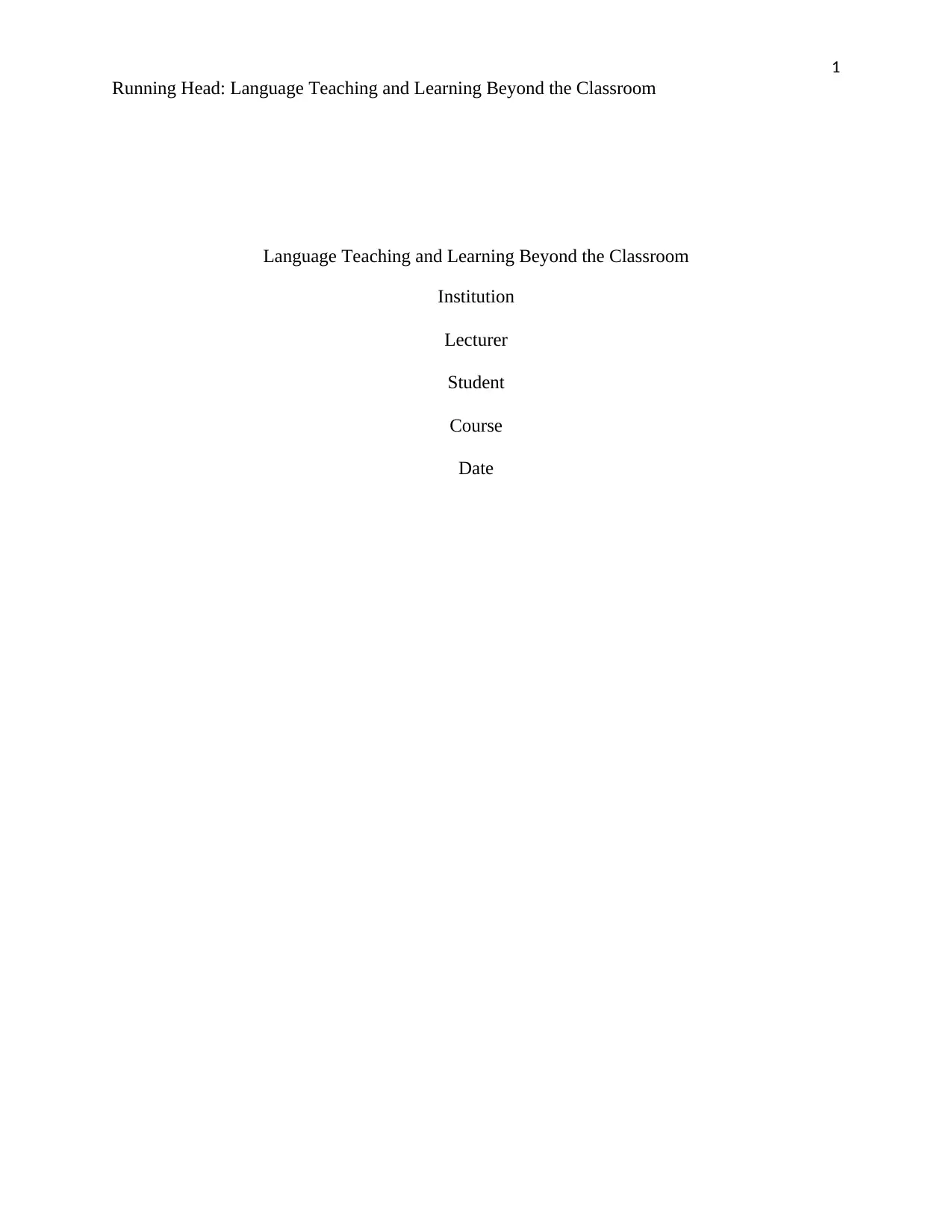
1
Running Head: Language Teaching and Learning Beyond the Classroom
Language Teaching and Learning Beyond the Classroom
Institution
Lecturer
Student
Course
Date
Running Head: Language Teaching and Learning Beyond the Classroom
Language Teaching and Learning Beyond the Classroom
Institution
Lecturer
Student
Course
Date
Paraphrase This Document
Need a fresh take? Get an instant paraphrase of this document with our AI Paraphraser
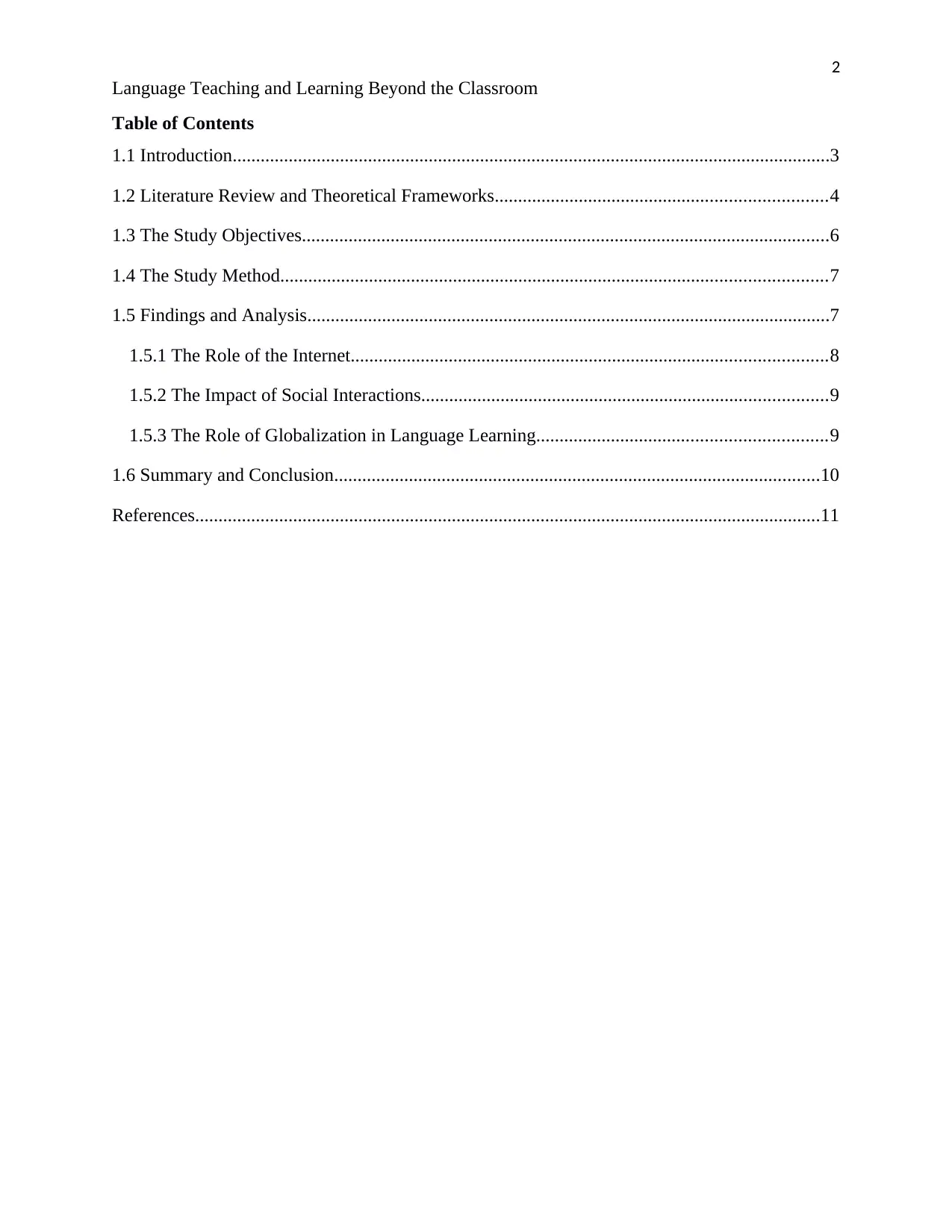
2
Language Teaching and Learning Beyond the Classroom
Table of Contents
1.1 Introduction................................................................................................................................3
1.2 Literature Review and Theoretical Frameworks.......................................................................4
1.3 The Study Objectives.................................................................................................................6
1.4 The Study Method.....................................................................................................................7
1.5 Findings and Analysis................................................................................................................7
1.5.1 The Role of the Internet......................................................................................................8
1.5.2 The Impact of Social Interactions.......................................................................................9
1.5.3 The Role of Globalization in Language Learning..............................................................9
1.6 Summary and Conclusion........................................................................................................10
References......................................................................................................................................11
Language Teaching and Learning Beyond the Classroom
Table of Contents
1.1 Introduction................................................................................................................................3
1.2 Literature Review and Theoretical Frameworks.......................................................................4
1.3 The Study Objectives.................................................................................................................6
1.4 The Study Method.....................................................................................................................7
1.5 Findings and Analysis................................................................................................................7
1.5.1 The Role of the Internet......................................................................................................8
1.5.2 The Impact of Social Interactions.......................................................................................9
1.5.3 The Role of Globalization in Language Learning..............................................................9
1.6 Summary and Conclusion........................................................................................................10
References......................................................................................................................................11
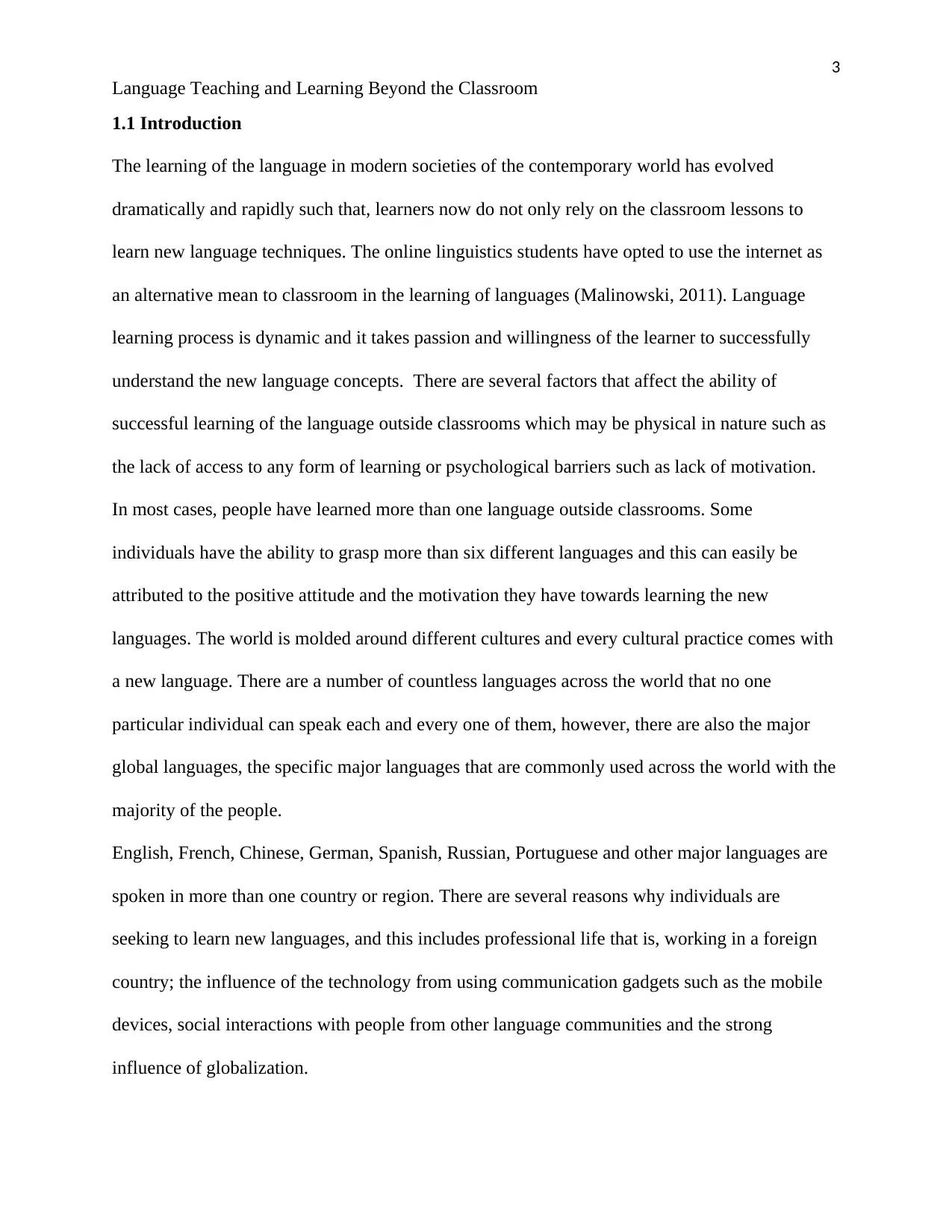
3
Language Teaching and Learning Beyond the Classroom
1.1 Introduction
The learning of the language in modern societies of the contemporary world has evolved
dramatically and rapidly such that, learners now do not only rely on the classroom lessons to
learn new language techniques. The online linguistics students have opted to use the internet as
an alternative mean to classroom in the learning of languages (Malinowski, 2011). Language
learning process is dynamic and it takes passion and willingness of the learner to successfully
understand the new language concepts. There are several factors that affect the ability of
successful learning of the language outside classrooms which may be physical in nature such as
the lack of access to any form of learning or psychological barriers such as lack of motivation.
In most cases, people have learned more than one language outside classrooms. Some
individuals have the ability to grasp more than six different languages and this can easily be
attributed to the positive attitude and the motivation they have towards learning the new
languages. The world is molded around different cultures and every cultural practice comes with
a new language. There are a number of countless languages across the world that no one
particular individual can speak each and every one of them, however, there are also the major
global languages, the specific major languages that are commonly used across the world with the
majority of the people.
English, French, Chinese, German, Spanish, Russian, Portuguese and other major languages are
spoken in more than one country or region. There are several reasons why individuals are
seeking to learn new languages, and this includes professional life that is, working in a foreign
country; the influence of the technology from using communication gadgets such as the mobile
devices, social interactions with people from other language communities and the strong
influence of globalization.
Language Teaching and Learning Beyond the Classroom
1.1 Introduction
The learning of the language in modern societies of the contemporary world has evolved
dramatically and rapidly such that, learners now do not only rely on the classroom lessons to
learn new language techniques. The online linguistics students have opted to use the internet as
an alternative mean to classroom in the learning of languages (Malinowski, 2011). Language
learning process is dynamic and it takes passion and willingness of the learner to successfully
understand the new language concepts. There are several factors that affect the ability of
successful learning of the language outside classrooms which may be physical in nature such as
the lack of access to any form of learning or psychological barriers such as lack of motivation.
In most cases, people have learned more than one language outside classrooms. Some
individuals have the ability to grasp more than six different languages and this can easily be
attributed to the positive attitude and the motivation they have towards learning the new
languages. The world is molded around different cultures and every cultural practice comes with
a new language. There are a number of countless languages across the world that no one
particular individual can speak each and every one of them, however, there are also the major
global languages, the specific major languages that are commonly used across the world with the
majority of the people.
English, French, Chinese, German, Spanish, Russian, Portuguese and other major languages are
spoken in more than one country or region. There are several reasons why individuals are
seeking to learn new languages, and this includes professional life that is, working in a foreign
country; the influence of the technology from using communication gadgets such as the mobile
devices, social interactions with people from other language communities and the strong
influence of globalization.
⊘ This is a preview!⊘
Do you want full access?
Subscribe today to unlock all pages.

Trusted by 1+ million students worldwide
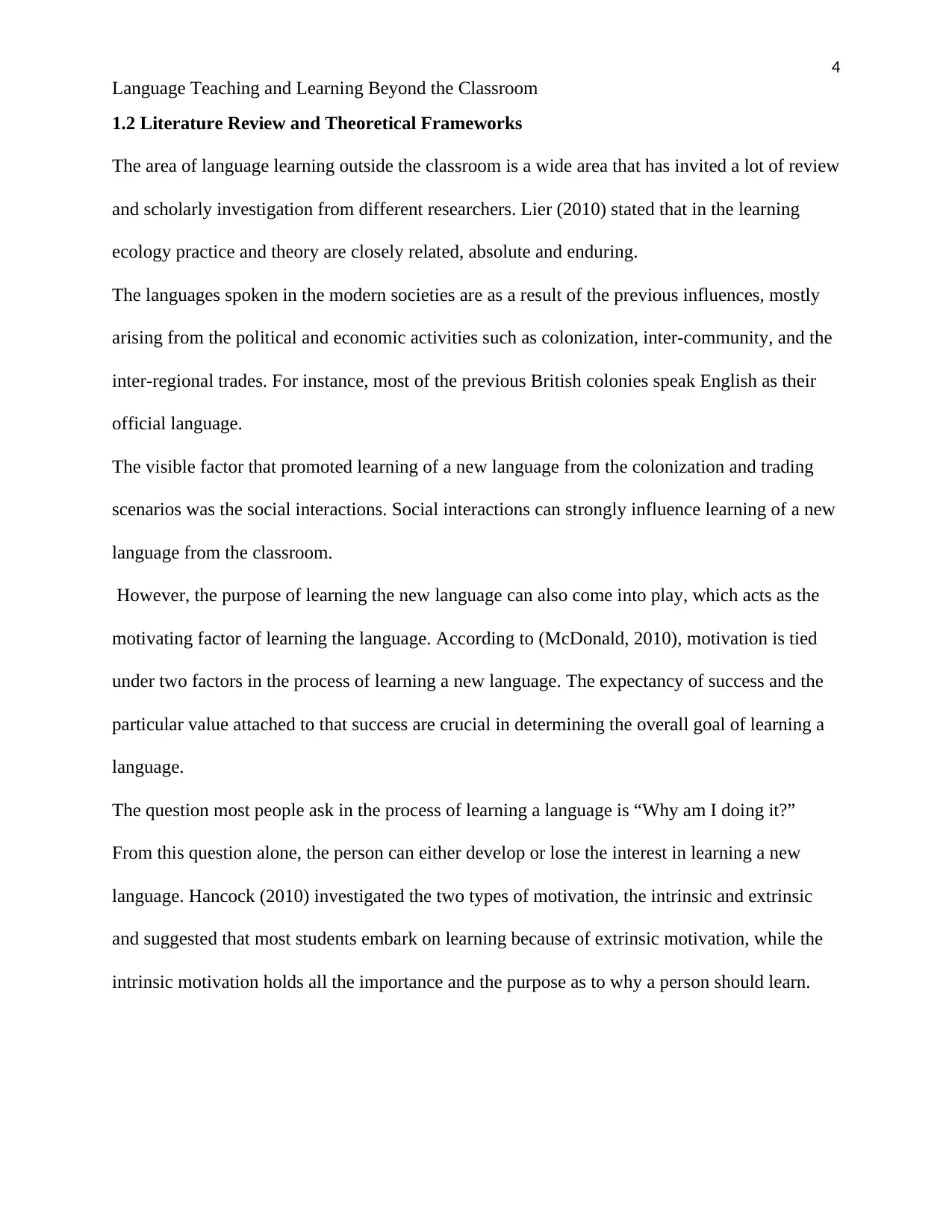
4
Language Teaching and Learning Beyond the Classroom
1.2 Literature Review and Theoretical Frameworks
The area of language learning outside the classroom is a wide area that has invited a lot of review
and scholarly investigation from different researchers. Lier (2010) stated that in the learning
ecology practice and theory are closely related, absolute and enduring.
The languages spoken in the modern societies are as a result of the previous influences, mostly
arising from the political and economic activities such as colonization, inter-community, and the
inter-regional trades. For instance, most of the previous British colonies speak English as their
official language.
The visible factor that promoted learning of a new language from the colonization and trading
scenarios was the social interactions. Social interactions can strongly influence learning of a new
language from the classroom.
However, the purpose of learning the new language can also come into play, which acts as the
motivating factor of learning the language. According to (McDonald, 2010), motivation is tied
under two factors in the process of learning a new language. The expectancy of success and the
particular value attached to that success are crucial in determining the overall goal of learning a
language.
The question most people ask in the process of learning a language is “Why am I doing it?”
From this question alone, the person can either develop or lose the interest in learning a new
language. Hancock (2010) investigated the two types of motivation, the intrinsic and extrinsic
and suggested that most students embark on learning because of extrinsic motivation, while the
intrinsic motivation holds all the importance and the purpose as to why a person should learn.
Language Teaching and Learning Beyond the Classroom
1.2 Literature Review and Theoretical Frameworks
The area of language learning outside the classroom is a wide area that has invited a lot of review
and scholarly investigation from different researchers. Lier (2010) stated that in the learning
ecology practice and theory are closely related, absolute and enduring.
The languages spoken in the modern societies are as a result of the previous influences, mostly
arising from the political and economic activities such as colonization, inter-community, and the
inter-regional trades. For instance, most of the previous British colonies speak English as their
official language.
The visible factor that promoted learning of a new language from the colonization and trading
scenarios was the social interactions. Social interactions can strongly influence learning of a new
language from the classroom.
However, the purpose of learning the new language can also come into play, which acts as the
motivating factor of learning the language. According to (McDonald, 2010), motivation is tied
under two factors in the process of learning a new language. The expectancy of success and the
particular value attached to that success are crucial in determining the overall goal of learning a
language.
The question most people ask in the process of learning a language is “Why am I doing it?”
From this question alone, the person can either develop or lose the interest in learning a new
language. Hancock (2010) investigated the two types of motivation, the intrinsic and extrinsic
and suggested that most students embark on learning because of extrinsic motivation, while the
intrinsic motivation holds all the importance and the purpose as to why a person should learn.
Paraphrase This Document
Need a fresh take? Get an instant paraphrase of this document with our AI Paraphraser
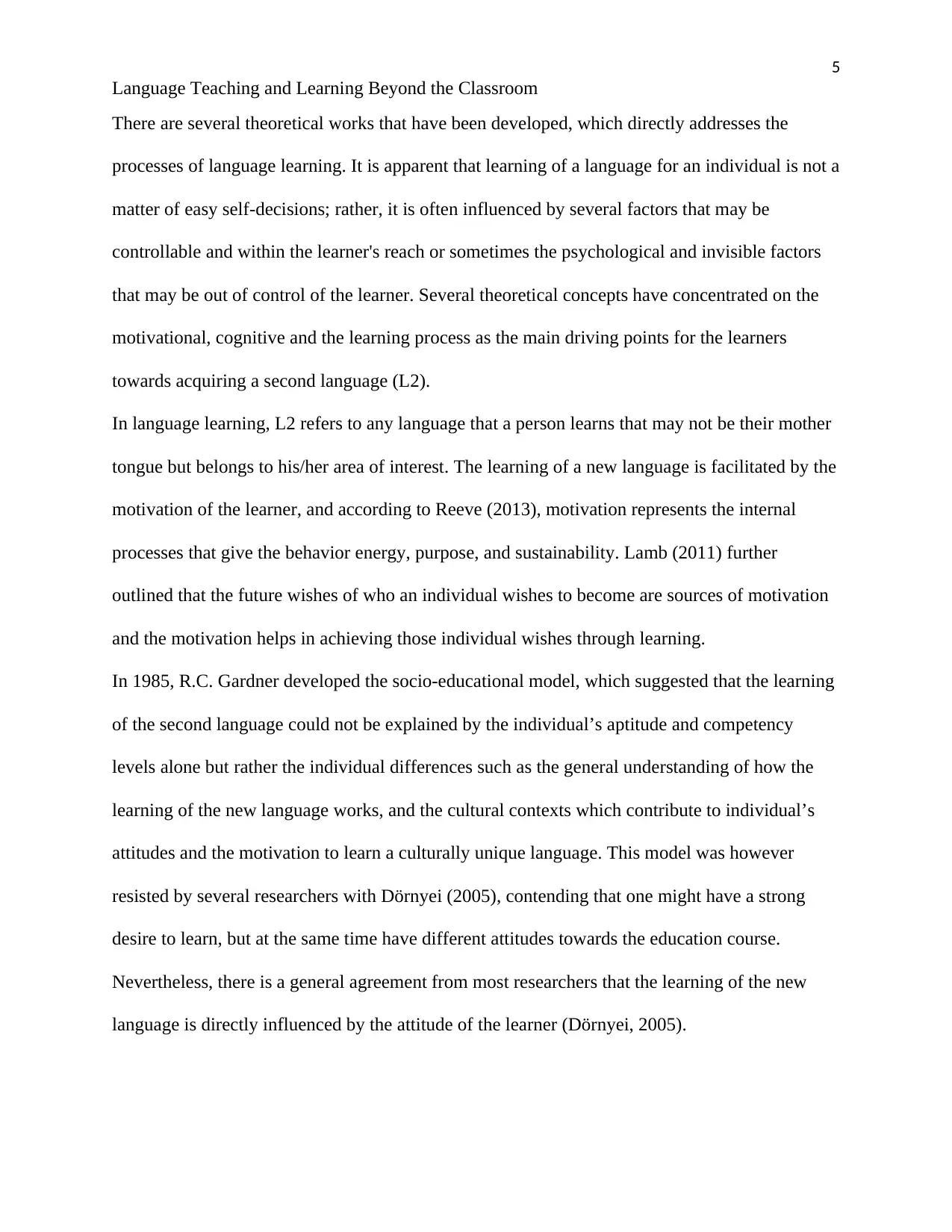
5
Language Teaching and Learning Beyond the Classroom
There are several theoretical works that have been developed, which directly addresses the
processes of language learning. It is apparent that learning of a language for an individual is not a
matter of easy self-decisions; rather, it is often influenced by several factors that may be
controllable and within the learner's reach or sometimes the psychological and invisible factors
that may be out of control of the learner. Several theoretical concepts have concentrated on the
motivational, cognitive and the learning process as the main driving points for the learners
towards acquiring a second language (L2).
In language learning, L2 refers to any language that a person learns that may not be their mother
tongue but belongs to his/her area of interest. The learning of a new language is facilitated by the
motivation of the learner, and according to Reeve (2013), motivation represents the internal
processes that give the behavior energy, purpose, and sustainability. Lamb (2011) further
outlined that the future wishes of who an individual wishes to become are sources of motivation
and the motivation helps in achieving those individual wishes through learning.
In 1985, R.C. Gardner developed the socio-educational model, which suggested that the learning
of the second language could not be explained by the individual’s aptitude and competency
levels alone but rather the individual differences such as the general understanding of how the
learning of the new language works, and the cultural contexts which contribute to individual’s
attitudes and the motivation to learn a culturally unique language. This model was however
resisted by several researchers with Dörnyei (2005), contending that one might have a strong
desire to learn, but at the same time have different attitudes towards the education course.
Nevertheless, there is a general agreement from most researchers that the learning of the new
language is directly influenced by the attitude of the learner (Dörnyei, 2005).
Language Teaching and Learning Beyond the Classroom
There are several theoretical works that have been developed, which directly addresses the
processes of language learning. It is apparent that learning of a language for an individual is not a
matter of easy self-decisions; rather, it is often influenced by several factors that may be
controllable and within the learner's reach or sometimes the psychological and invisible factors
that may be out of control of the learner. Several theoretical concepts have concentrated on the
motivational, cognitive and the learning process as the main driving points for the learners
towards acquiring a second language (L2).
In language learning, L2 refers to any language that a person learns that may not be their mother
tongue but belongs to his/her area of interest. The learning of a new language is facilitated by the
motivation of the learner, and according to Reeve (2013), motivation represents the internal
processes that give the behavior energy, purpose, and sustainability. Lamb (2011) further
outlined that the future wishes of who an individual wishes to become are sources of motivation
and the motivation helps in achieving those individual wishes through learning.
In 1985, R.C. Gardner developed the socio-educational model, which suggested that the learning
of the second language could not be explained by the individual’s aptitude and competency
levels alone but rather the individual differences such as the general understanding of how the
learning of the new language works, and the cultural contexts which contribute to individual’s
attitudes and the motivation to learn a culturally unique language. This model was however
resisted by several researchers with Dörnyei (2005), contending that one might have a strong
desire to learn, but at the same time have different attitudes towards the education course.
Nevertheless, there is a general agreement from most researchers that the learning of the new
language is directly influenced by the attitude of the learner (Dörnyei, 2005).
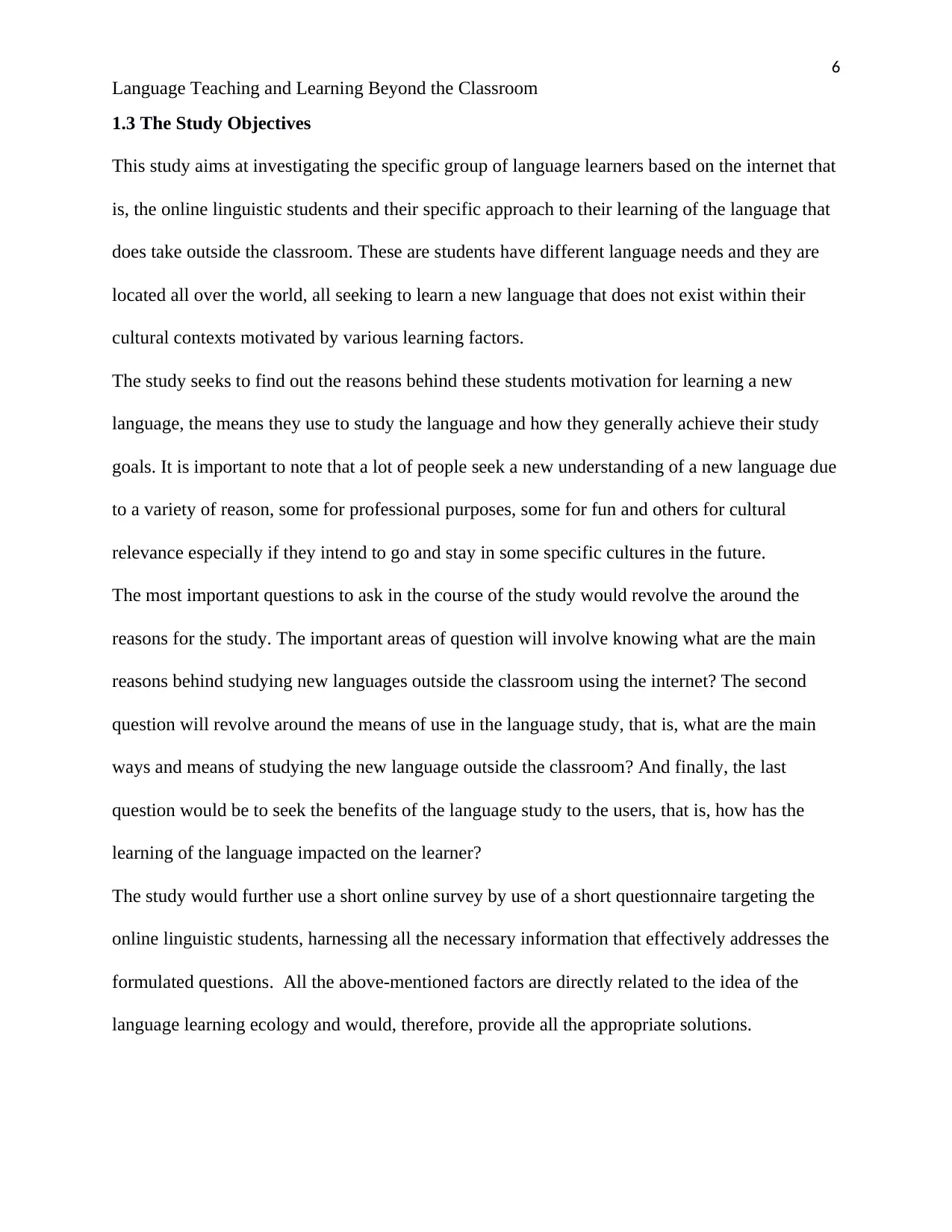
6
Language Teaching and Learning Beyond the Classroom
1.3 The Study Objectives
This study aims at investigating the specific group of language learners based on the internet that
is, the online linguistic students and their specific approach to their learning of the language that
does take outside the classroom. These are students have different language needs and they are
located all over the world, all seeking to learn a new language that does not exist within their
cultural contexts motivated by various learning factors.
The study seeks to find out the reasons behind these students motivation for learning a new
language, the means they use to study the language and how they generally achieve their study
goals. It is important to note that a lot of people seek a new understanding of a new language due
to a variety of reason, some for professional purposes, some for fun and others for cultural
relevance especially if they intend to go and stay in some specific cultures in the future.
The most important questions to ask in the course of the study would revolve the around the
reasons for the study. The important areas of question will involve knowing what are the main
reasons behind studying new languages outside the classroom using the internet? The second
question will revolve around the means of use in the language study, that is, what are the main
ways and means of studying the new language outside the classroom? And finally, the last
question would be to seek the benefits of the language study to the users, that is, how has the
learning of the language impacted on the learner?
The study would further use a short online survey by use of a short questionnaire targeting the
online linguistic students, harnessing all the necessary information that effectively addresses the
formulated questions. All the above-mentioned factors are directly related to the idea of the
language learning ecology and would, therefore, provide all the appropriate solutions.
Language Teaching and Learning Beyond the Classroom
1.3 The Study Objectives
This study aims at investigating the specific group of language learners based on the internet that
is, the online linguistic students and their specific approach to their learning of the language that
does take outside the classroom. These are students have different language needs and they are
located all over the world, all seeking to learn a new language that does not exist within their
cultural contexts motivated by various learning factors.
The study seeks to find out the reasons behind these students motivation for learning a new
language, the means they use to study the language and how they generally achieve their study
goals. It is important to note that a lot of people seek a new understanding of a new language due
to a variety of reason, some for professional purposes, some for fun and others for cultural
relevance especially if they intend to go and stay in some specific cultures in the future.
The most important questions to ask in the course of the study would revolve the around the
reasons for the study. The important areas of question will involve knowing what are the main
reasons behind studying new languages outside the classroom using the internet? The second
question will revolve around the means of use in the language study, that is, what are the main
ways and means of studying the new language outside the classroom? And finally, the last
question would be to seek the benefits of the language study to the users, that is, how has the
learning of the language impacted on the learner?
The study would further use a short online survey by use of a short questionnaire targeting the
online linguistic students, harnessing all the necessary information that effectively addresses the
formulated questions. All the above-mentioned factors are directly related to the idea of the
language learning ecology and would, therefore, provide all the appropriate solutions.
⊘ This is a preview!⊘
Do you want full access?
Subscribe today to unlock all pages.

Trusted by 1+ million students worldwide
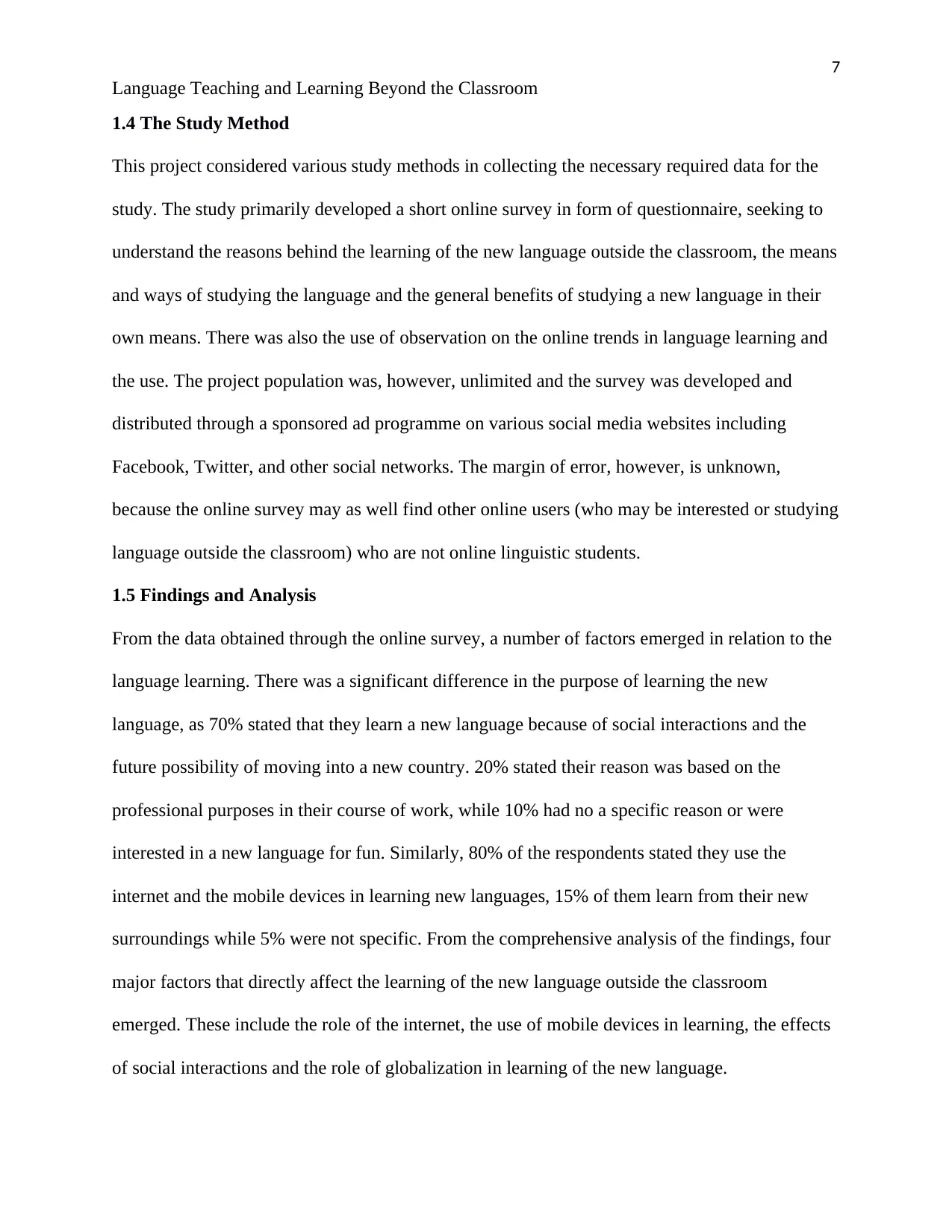
7
Language Teaching and Learning Beyond the Classroom
1.4 The Study Method
This project considered various study methods in collecting the necessary required data for the
study. The study primarily developed a short online survey in form of questionnaire, seeking to
understand the reasons behind the learning of the new language outside the classroom, the means
and ways of studying the language and the general benefits of studying a new language in their
own means. There was also the use of observation on the online trends in language learning and
the use. The project population was, however, unlimited and the survey was developed and
distributed through a sponsored ad programme on various social media websites including
Facebook, Twitter, and other social networks. The margin of error, however, is unknown,
because the online survey may as well find other online users (who may be interested or studying
language outside the classroom) who are not online linguistic students.
1.5 Findings and Analysis
From the data obtained through the online survey, a number of factors emerged in relation to the
language learning. There was a significant difference in the purpose of learning the new
language, as 70% stated that they learn a new language because of social interactions and the
future possibility of moving into a new country. 20% stated their reason was based on the
professional purposes in their course of work, while 10% had no a specific reason or were
interested in a new language for fun. Similarly, 80% of the respondents stated they use the
internet and the mobile devices in learning new languages, 15% of them learn from their new
surroundings while 5% were not specific. From the comprehensive analysis of the findings, four
major factors that directly affect the learning of the new language outside the classroom
emerged. These include the role of the internet, the use of mobile devices in learning, the effects
of social interactions and the role of globalization in learning of the new language.
Language Teaching and Learning Beyond the Classroom
1.4 The Study Method
This project considered various study methods in collecting the necessary required data for the
study. The study primarily developed a short online survey in form of questionnaire, seeking to
understand the reasons behind the learning of the new language outside the classroom, the means
and ways of studying the language and the general benefits of studying a new language in their
own means. There was also the use of observation on the online trends in language learning and
the use. The project population was, however, unlimited and the survey was developed and
distributed through a sponsored ad programme on various social media websites including
Facebook, Twitter, and other social networks. The margin of error, however, is unknown,
because the online survey may as well find other online users (who may be interested or studying
language outside the classroom) who are not online linguistic students.
1.5 Findings and Analysis
From the data obtained through the online survey, a number of factors emerged in relation to the
language learning. There was a significant difference in the purpose of learning the new
language, as 70% stated that they learn a new language because of social interactions and the
future possibility of moving into a new country. 20% stated their reason was based on the
professional purposes in their course of work, while 10% had no a specific reason or were
interested in a new language for fun. Similarly, 80% of the respondents stated they use the
internet and the mobile devices in learning new languages, 15% of them learn from their new
surroundings while 5% were not specific. From the comprehensive analysis of the findings, four
major factors that directly affect the learning of the new language outside the classroom
emerged. These include the role of the internet, the use of mobile devices in learning, the effects
of social interactions and the role of globalization in learning of the new language.
Paraphrase This Document
Need a fresh take? Get an instant paraphrase of this document with our AI Paraphraser
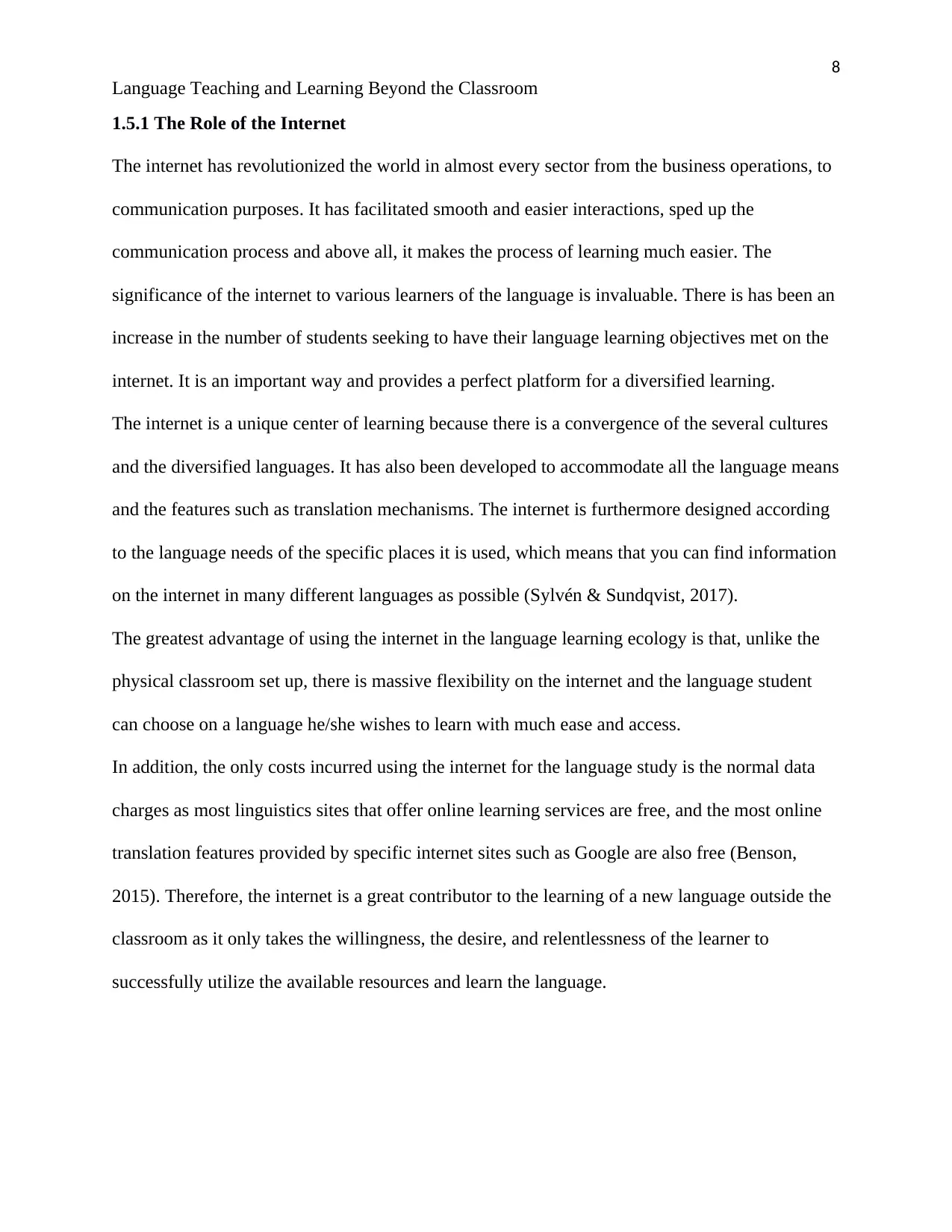
8
Language Teaching and Learning Beyond the Classroom
1.5.1 The Role of the Internet
The internet has revolutionized the world in almost every sector from the business operations, to
communication purposes. It has facilitated smooth and easier interactions, sped up the
communication process and above all, it makes the process of learning much easier. The
significance of the internet to various learners of the language is invaluable. There is has been an
increase in the number of students seeking to have their language learning objectives met on the
internet. It is an important way and provides a perfect platform for a diversified learning.
The internet is a unique center of learning because there is a convergence of the several cultures
and the diversified languages. It has also been developed to accommodate all the language means
and the features such as translation mechanisms. The internet is furthermore designed according
to the language needs of the specific places it is used, which means that you can find information
on the internet in many different languages as possible (Sylvén & Sundqvist, 2017).
The greatest advantage of using the internet in the language learning ecology is that, unlike the
physical classroom set up, there is massive flexibility on the internet and the language student
can choose on a language he/she wishes to learn with much ease and access.
In addition, the only costs incurred using the internet for the language study is the normal data
charges as most linguistics sites that offer online learning services are free, and the most online
translation features provided by specific internet sites such as Google are also free (Benson,
2015). Therefore, the internet is a great contributor to the learning of a new language outside the
classroom as it only takes the willingness, the desire, and relentlessness of the learner to
successfully utilize the available resources and learn the language.
Language Teaching and Learning Beyond the Classroom
1.5.1 The Role of the Internet
The internet has revolutionized the world in almost every sector from the business operations, to
communication purposes. It has facilitated smooth and easier interactions, sped up the
communication process and above all, it makes the process of learning much easier. The
significance of the internet to various learners of the language is invaluable. There is has been an
increase in the number of students seeking to have their language learning objectives met on the
internet. It is an important way and provides a perfect platform for a diversified learning.
The internet is a unique center of learning because there is a convergence of the several cultures
and the diversified languages. It has also been developed to accommodate all the language means
and the features such as translation mechanisms. The internet is furthermore designed according
to the language needs of the specific places it is used, which means that you can find information
on the internet in many different languages as possible (Sylvén & Sundqvist, 2017).
The greatest advantage of using the internet in the language learning ecology is that, unlike the
physical classroom set up, there is massive flexibility on the internet and the language student
can choose on a language he/she wishes to learn with much ease and access.
In addition, the only costs incurred using the internet for the language study is the normal data
charges as most linguistics sites that offer online learning services are free, and the most online
translation features provided by specific internet sites such as Google are also free (Benson,
2015). Therefore, the internet is a great contributor to the learning of a new language outside the
classroom as it only takes the willingness, the desire, and relentlessness of the learner to
successfully utilize the available resources and learn the language.
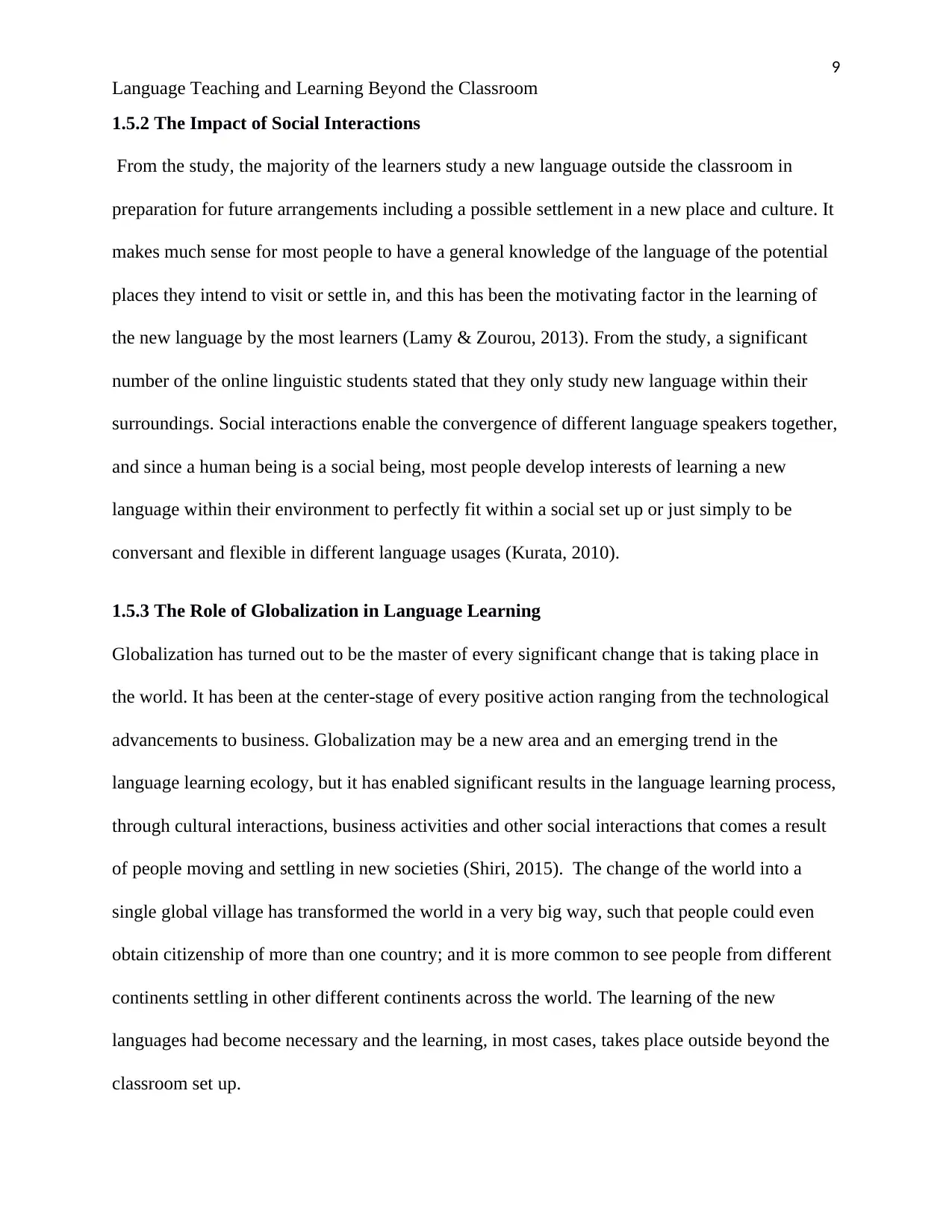
9
Language Teaching and Learning Beyond the Classroom
1.5.2 The Impact of Social Interactions
From the study, the majority of the learners study a new language outside the classroom in
preparation for future arrangements including a possible settlement in a new place and culture. It
makes much sense for most people to have a general knowledge of the language of the potential
places they intend to visit or settle in, and this has been the motivating factor in the learning of
the new language by the most learners (Lamy & Zourou, 2013). From the study, a significant
number of the online linguistic students stated that they only study new language within their
surroundings. Social interactions enable the convergence of different language speakers together,
and since a human being is a social being, most people develop interests of learning a new
language within their environment to perfectly fit within a social set up or just simply to be
conversant and flexible in different language usages (Kurata, 2010).
1.5.3 The Role of Globalization in Language Learning
Globalization has turned out to be the master of every significant change that is taking place in
the world. It has been at the center-stage of every positive action ranging from the technological
advancements to business. Globalization may be a new area and an emerging trend in the
language learning ecology, but it has enabled significant results in the language learning process,
through cultural interactions, business activities and other social interactions that comes a result
of people moving and settling in new societies (Shiri, 2015). The change of the world into a
single global village has transformed the world in a very big way, such that people could even
obtain citizenship of more than one country; and it is more common to see people from different
continents settling in other different continents across the world. The learning of the new
languages had become necessary and the learning, in most cases, takes place outside beyond the
classroom set up.
Language Teaching and Learning Beyond the Classroom
1.5.2 The Impact of Social Interactions
From the study, the majority of the learners study a new language outside the classroom in
preparation for future arrangements including a possible settlement in a new place and culture. It
makes much sense for most people to have a general knowledge of the language of the potential
places they intend to visit or settle in, and this has been the motivating factor in the learning of
the new language by the most learners (Lamy & Zourou, 2013). From the study, a significant
number of the online linguistic students stated that they only study new language within their
surroundings. Social interactions enable the convergence of different language speakers together,
and since a human being is a social being, most people develop interests of learning a new
language within their environment to perfectly fit within a social set up or just simply to be
conversant and flexible in different language usages (Kurata, 2010).
1.5.3 The Role of Globalization in Language Learning
Globalization has turned out to be the master of every significant change that is taking place in
the world. It has been at the center-stage of every positive action ranging from the technological
advancements to business. Globalization may be a new area and an emerging trend in the
language learning ecology, but it has enabled significant results in the language learning process,
through cultural interactions, business activities and other social interactions that comes a result
of people moving and settling in new societies (Shiri, 2015). The change of the world into a
single global village has transformed the world in a very big way, such that people could even
obtain citizenship of more than one country; and it is more common to see people from different
continents settling in other different continents across the world. The learning of the new
languages had become necessary and the learning, in most cases, takes place outside beyond the
classroom set up.
⊘ This is a preview!⊘
Do you want full access?
Subscribe today to unlock all pages.

Trusted by 1+ million students worldwide
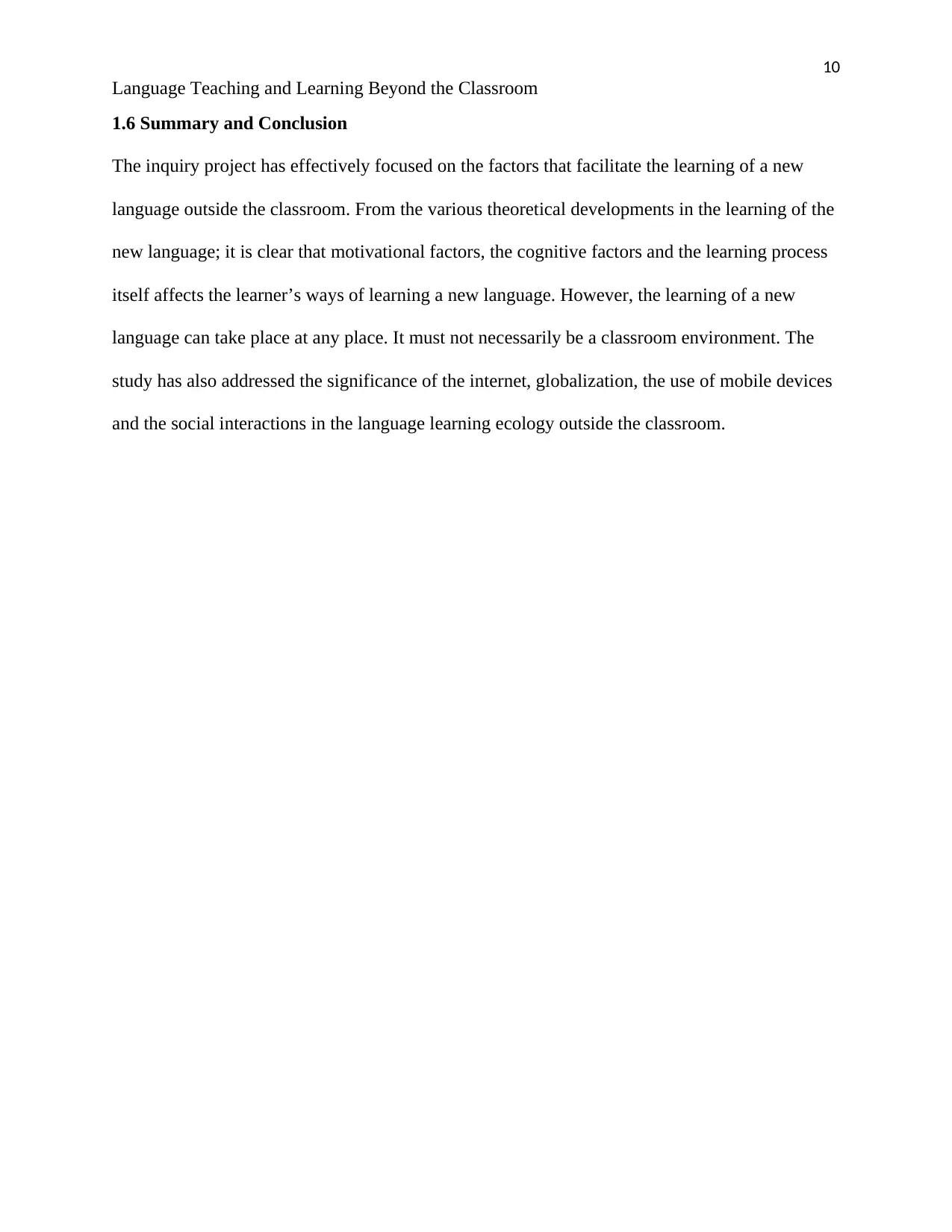
10
Language Teaching and Learning Beyond the Classroom
1.6 Summary and Conclusion
The inquiry project has effectively focused on the factors that facilitate the learning of a new
language outside the classroom. From the various theoretical developments in the learning of the
new language; it is clear that motivational factors, the cognitive factors and the learning process
itself affects the learner’s ways of learning a new language. However, the learning of a new
language can take place at any place. It must not necessarily be a classroom environment. The
study has also addressed the significance of the internet, globalization, the use of mobile devices
and the social interactions in the language learning ecology outside the classroom.
Language Teaching and Learning Beyond the Classroom
1.6 Summary and Conclusion
The inquiry project has effectively focused on the factors that facilitate the learning of a new
language outside the classroom. From the various theoretical developments in the learning of the
new language; it is clear that motivational factors, the cognitive factors and the learning process
itself affects the learner’s ways of learning a new language. However, the learning of a new
language can take place at any place. It must not necessarily be a classroom environment. The
study has also addressed the significance of the internet, globalization, the use of mobile devices
and the social interactions in the language learning ecology outside the classroom.
Paraphrase This Document
Need a fresh take? Get an instant paraphrase of this document with our AI Paraphraser
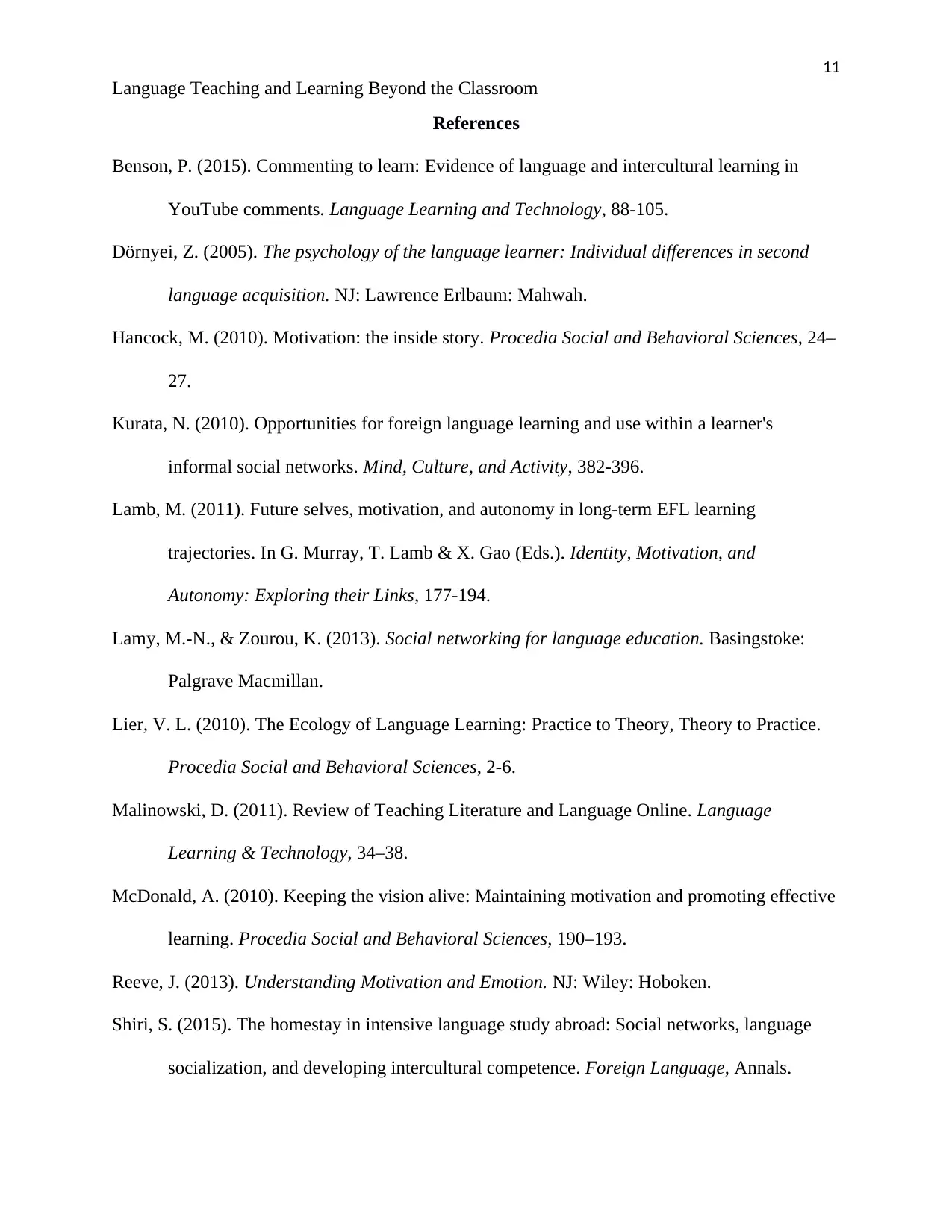
11
Language Teaching and Learning Beyond the Classroom
References
Benson, P. (2015). Commenting to learn: Evidence of language and intercultural learning in
YouTube comments. Language Learning and Technology, 88-105.
Dörnyei, Z. (2005). The psychology of the language learner: Individual differences in second
language acquisition. NJ: Lawrence Erlbaum: Mahwah.
Hancock, M. (2010). Motivation: the inside story. Procedia Social and Behavioral Sciences, 24–
27.
Kurata, N. (2010). Opportunities for foreign language learning and use within a learner's
informal social networks. Mind, Culture, and Activity, 382-396.
Lamb, M. (2011). Future selves, motivation, and autonomy in long-term EFL learning
trajectories. In G. Murray, T. Lamb & X. Gao (Eds.). Identity, Motivation, and
Autonomy: Exploring their Links, 177-194.
Lamy, M.-N., & Zourou, K. (2013). Social networking for language education. Basingstoke:
Palgrave Macmillan.
Lier, V. L. (2010). The Ecology of Language Learning: Practice to Theory, Theory to Practice.
Procedia Social and Behavioral Sciences, 2-6.
Malinowski, D. (2011). Review of Teaching Literature and Language Online. Language
Learning & Technology, 34–38.
McDonald, A. (2010). Keeping the vision alive: Maintaining motivation and promoting effective
learning. Procedia Social and Behavioral Sciences, 190–193.
Reeve, J. (2013). Understanding Motivation and Emotion. NJ: Wiley: Hoboken.
Shiri, S. (2015). The homestay in intensive language study abroad: Social networks, language
socialization, and developing intercultural competence. Foreign Language, Annals.
Language Teaching and Learning Beyond the Classroom
References
Benson, P. (2015). Commenting to learn: Evidence of language and intercultural learning in
YouTube comments. Language Learning and Technology, 88-105.
Dörnyei, Z. (2005). The psychology of the language learner: Individual differences in second
language acquisition. NJ: Lawrence Erlbaum: Mahwah.
Hancock, M. (2010). Motivation: the inside story. Procedia Social and Behavioral Sciences, 24–
27.
Kurata, N. (2010). Opportunities for foreign language learning and use within a learner's
informal social networks. Mind, Culture, and Activity, 382-396.
Lamb, M. (2011). Future selves, motivation, and autonomy in long-term EFL learning
trajectories. In G. Murray, T. Lamb & X. Gao (Eds.). Identity, Motivation, and
Autonomy: Exploring their Links, 177-194.
Lamy, M.-N., & Zourou, K. (2013). Social networking for language education. Basingstoke:
Palgrave Macmillan.
Lier, V. L. (2010). The Ecology of Language Learning: Practice to Theory, Theory to Practice.
Procedia Social and Behavioral Sciences, 2-6.
Malinowski, D. (2011). Review of Teaching Literature and Language Online. Language
Learning & Technology, 34–38.
McDonald, A. (2010). Keeping the vision alive: Maintaining motivation and promoting effective
learning. Procedia Social and Behavioral Sciences, 190–193.
Reeve, J. (2013). Understanding Motivation and Emotion. NJ: Wiley: Hoboken.
Shiri, S. (2015). The homestay in intensive language study abroad: Social networks, language
socialization, and developing intercultural competence. Foreign Language, Annals.

12
Language Teaching and Learning Beyond the Classroom
Sylvén, L. K., & Sundqvist, P. (2017). Computer-assisted language learning (CALL) in
extracurricular/extramural contexts. CALICO Journal, 1-4.
Language Teaching and Learning Beyond the Classroom
Sylvén, L. K., & Sundqvist, P. (2017). Computer-assisted language learning (CALL) in
extracurricular/extramural contexts. CALICO Journal, 1-4.
⊘ This is a preview!⊘
Do you want full access?
Subscribe today to unlock all pages.

Trusted by 1+ million students worldwide
1 out of 12
Related Documents
Your All-in-One AI-Powered Toolkit for Academic Success.
+13062052269
info@desklib.com
Available 24*7 on WhatsApp / Email
![[object Object]](/_next/static/media/star-bottom.7253800d.svg)
Unlock your academic potential
Copyright © 2020–2025 A2Z Services. All Rights Reserved. Developed and managed by ZUCOL.





